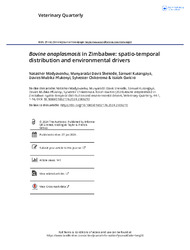| dc.contributor.author | Madyavanhu, Natasher | |
| dc.contributor.author | Shekede, Munyaradzi Davis | |
| dc.contributor.author | Kusangaya, Samuel | |
| dc.contributor.author | Pfukenyi, Davies Mubika | |
| dc.contributor.author | Chikerema, Sylvester | |
| dc.contributor.author | Gwitira, Isaiah | |
| dc.date.accessioned | 2024-02-05T08:32:26Z | |
| dc.date.available | 2024-02-05T08:32:26Z | |
| dc.date.issued | 2024-01-27 | |
| dc.identifier.citation | Madyavanhu, N., Shekede, M. D., Kusangaya, S., Pfukenyi, D. M., Chikerema, S., & Gwitira, I. (2024). Bovine anaplasmosis in Zimbabwe: spatio-temporal distribution and environmental drivers. Veterinary Quarterly, 44(1), 1-16. | en_US |
| dc.identifier.issn | 01652176 | |
| dc.identifier.uri | 10.1080/01652176.2024.2306210 | |
| dc.identifier.uri | https://www.tandfonline.com/journals/TVEQ | |
| dc.identifier.uri | https://hdl.handle.net/13049/729 | |
| dc.description | This is an Open Access article distributed under the terms of the Creative Commons Attribution-NonCommercial License, CC BY-NC 4.0 | en_US |
| dc.description.abstract | Understanding the spatial and temporal distribution of Bovine anaplasmosis is crucial for identifying areas of high prevalence for targeted disease control. This research was aimed at modelling and mapping the B. anaplasmosis potential distribution, and identify hotspots as well as significant variables explaining the occurrence of the disease. The Getis Ord Gi* statistic for Hotspot analysis was used as well as MaxEnt ecological niche modelling. The effects of time, land-use, and agro-ecological regions on B. anaplasmosis occurrence were tested using Analysis of Variance (ANOVA). Results showed that several districts in Zimbabwe are suitable for the occurence of the disease for example Binga, Seke, Buhera, Kwekwe, Gweru, Mhondoro, Chegutu, Sanyati, and in the North: Mbire, Muzarabani, Mt Darwin, Shamva, Bindura, Zvimba and Makonde. Morbidity and mortality hotspots were detected in Gokwe-south, Kwekwe, and Chirumhanzu districts. Binga, Gokwe-south, Gutu, Hurungwe, Mazoe, Nkayi, Shamva, and Kwekwe districts also experienced high disease incidences. Temperature seasonality, precipitation seasonality, mean diurnal range, and isothermality were the most important variables in explaining 93% of B. anaplasmosis distribution. Unlike land-use and agro-ecological regions, time (months) had a significant effect on B. anaplasmosis occurrence with July and September having significantly (p < 0.05) higher cases and deaths than the rest of the months. The results of this study provide insights into the management strategies and control of B. anaplasmosis in Zimbabwe. It is thus concluded that geo-spatial techniques, combined with ecological niche modelling can provide useful insights into disease prevalence and distribution and hence can contribute to effective management and control of B. anaplasmosis in Zimbabwe. | en_US |
| dc.language.iso | en | en_US |
| dc.publisher | Taylor and Francis Ltd. | en_US |
| dc.relation.ispartofseries | Veterinary Quarterly;44(1), 1-16. | |
| dc.subject | Bovine anaplasmosis | en_US |
| dc.subject | Clustering | en_US |
| dc.subject | Hotspot | en_US |
| dc.subject | MaxEnt | en_US |
| dc.subject | Spatio-temporal distribution | en_US |
| dc.title | Bovine anaplasmosis in Zimbabwe: spatio-temporal distribution and environmental drivers. | en_US |
| dc.type | Article | en_US |

